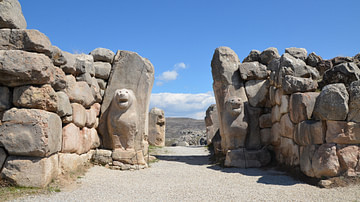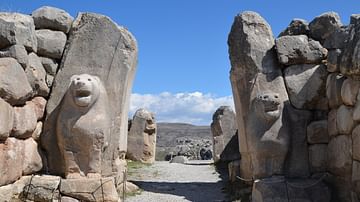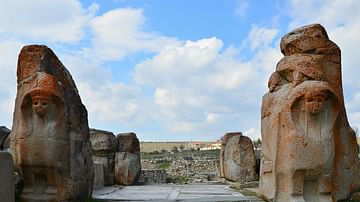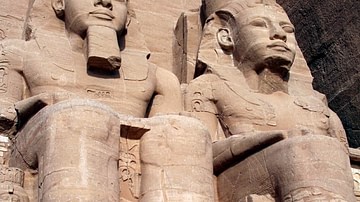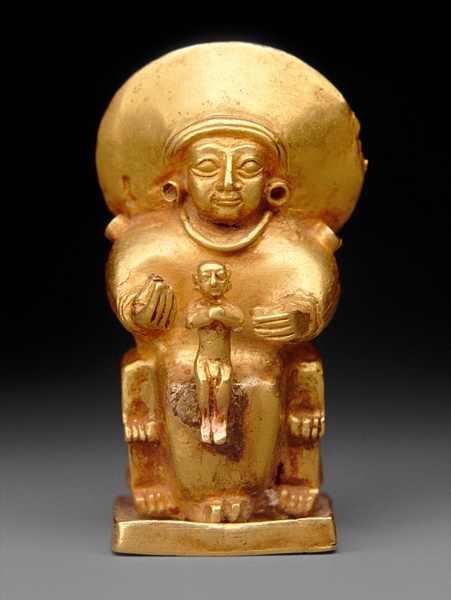
Sauska (also known as Shaushka, Sausga, and Anzili) was the Hurrian-Hittite goddess of fertility, war, and healing. She was worshipped throughout the region known as Hanigalbat (present day Iraq, Syria, and Turkey) from the time of the Hurrians (c. 3300 BCE), through the Kingdom of Mitanni (1500-1240 BCE), throughout the Hittite Empire (c.1344-1245 BCE), and beyond.
She is identified with similar powerful female deities of other cultures, such as Innana/Ishtar of the Akkadians and Assyrians, Isis of Egypt, Astarte of the Phoenicians, Usha (Ushas) of the Rig Veda of India, Aphrodite of the Greeks (who became the Venus of the Romans), and Amaterasu of Japan. Through her link with Astarte, she is also identified with the divine Semiramis of Mesopotamia, who was made famous through the legends recorded by Greek historians.
Like these other goddesses, Sauska was called upon to increase fertility (meaning both one's ability to conceive a child and one's physical beauty, as well as the fertility of the earth), for success in military conquest or business, and for protection and healing. She was also believed to shine her radiant light into the darkness of the human mind and allow for illumination and transcendence. The goddesses Usha and Amaterasu are both famous for this particular role in human affairs and, it seems, this quality was first emphasized in Sauska, although some historians claim that Usha may have been envisioned first, and others cite Isis or Inanna/Ishtar as the original prototype of this goddess.
It is most likely that the Hurrians conceived of their goddess through interaction with the people of Mesopotamia and that Inanna/Ishtar was the first goddess of this type, but this claim is regularly debated in the present day as it has been for centuries. It has been proposed, to cite only two lines of argument, that Sauska was the original prototype upon whom Inanna, and then Ishtar, was based.
Dr. Liny Srinivasan, however, a linguist and historian, maintains that "Sauska was the Hurrian name of the goddess of Washukanni" who was previously "the Egyptian goddess Isis...and the same Rigveda Usha" (483). She, therefore, claims that Isis was the original goddess upon whom the others were based. Archaeological evidence to support the claims of various scholars is invariably interpreted in the light of their respective biases, and so concluding which goddess came first is a matter of which scholar's claim one finds most convincing.
Sauska in the Amarna Letters
Sauska was extremely important to the Hurrians and, later, the Mitanni and the Hittites who came after them. She was also honored in Egypt as a visiting deity as evidenced in the Amarna Letters (correspondence between Egyptian pharaohs and rulers of other nations found in the city of Amarna). There are at least two letters from kings of Mitanni to Egypt referencing Sauska.
When the Mitanni king Tushratta sent his daughter, Taduhepa, to Egypt to be married, he also sent along a statue of Sauska. Historian Arielle P. Kozloff notes that Tushratta sent an enormous dowry to Egypt along with his daughter, whose marriage to Amenhotep III (as one of his lesser wives) was agreed upon to finalize a treaty between Egypt and Mitanni. This dowry included jewelry, gold, bronze, and silver, all in vast quantities, but, as Kozloff writes:
Tushratta's most touching gift of all was the loan of his favorite goddess, Sauska, to Amenhotep III. Sauska was the Hurrian-Hittite goddess of love, and Tushratta had called on her previously to make Tadu-Hepa attractive to her new husband. This was not the first time an eastern goddess had been honored by royalty in Egypt. Astarte, the Near Eastern fertility goddess, was first worshipped there under Amenhotep II...but Sauska was also similar to [the Egyptian goddess] Mut and had some responsibility for both healing and war. It seems the salutary aspect of Sauska suddenly became more important. In a letter to Amenhotep III, apparently accompanying the Sauska idol, Tushratta asked not for her erotic inspiration but for her protection. He wrote,
"Thus Sauska of Nineveh, mistress of all the lands, says: 'I wish to go to Egypt, a country that I love, and then return.' Now, I herewith send her, and she is on her way. Now, in the time, too, of my father [she] went to this country and just as earlier she dwelt there and they honored her, may my brother honor her, then at his pleasure let her go so that she may come back. May Sauska, the mistress of heaven, protect us, my brother and me, 100,000 years, and may our mistress grant both of us great joy." (220)
Sauska's powers, or Tushratta's prayers, in this particular instance proved to be of no avail, as Egypt shortly afterwards withdrew its support of Tushratta in fear of the growing power of the Hittites. In c. 1344 BCE the Hittite king Suppiluliuma I marched on Washukanni and, without Egyptian support, the city fell and Tushratta was assassinated by his son. This campaign ended the Kingdom of the Mitanni, which was afterwards ruled by the Hittites. Sauska was the patron goddess of the Hittite king Hatusili III, famous for his participation in the Treaty of Kadesh between the Hittites and Egypt in 1258 BCE, and there is evidence she was equally revered by other Hittite rulers.
Sauska in The Kumarbi Cycle
The Hittites produced the best known tales concerning Sauska through the stories known as The Kumarbi Cycle. These songs were no doubt Hurrian in origin but only exist today in fragments from the Hittite period in Anatolia. The Kumarbi Cycle tells the story of Kumarbi, the chief god of the Hurrians (identified with the Sumerian god Enlil), his dissatisfaction with human beings, and his two attempts to destroy them.
The Cycle consists of five (sometimes six) tales, which include two featuring Sauska: The Song of Hedammu, and The Song of Illikummi. The Song of Birth (also known as The Song of Kumarbi and The Kingship in Heaven) begins the cycle with the gods Anu and Kumarbi in conflict over who will rule the universe.
The Song of Birth relates how Teshub, the popular storm god, came to be conceived when the sky god Anu impregnated his son, the earth god Kumarbi, in battle. Kumarbi bites off Anu's genitals in the course of the battle, becomes pregnant, and then gives birth to Teshub through the top of his head. Scholar Mary Bachvarova, whose essay is included in Mark Chavalas' Women in the Ancient Near East: A Sourcebook, notes that "the Hurro-Hittite story provides for the perfect combination of heaven (Anu) and earth (Kumarbi) in a single god, who is therefore invincible" (12). This invincible god is Teshub (also known as Tarhun and Tessub), the storm god who will join forces with his grandfather/father Anu to eventually defeat Kumarbi.
Bachvarova notes that, "there are obvious comparisons with the myths of the castration of Ouranos by his son Kronos, the swallowing and subsequent vomiting forth of his children by Kronos, when fed a rock by his wife, and with the birth of Aphrodite, who issues forth from the head of Zeus" (12). Teshub is later featured as a great hero and champion of humanity. Interestingly, however, it is not Teshub who initially thwarts the designs of Kumarbi to destroy human life; it is Sauska in the first instance and Ea, the god of wisdom, in the second.
The first attempt by Kumarbi to destroy human beings is told in The Song of Hedammu, where Kumarbi mates with the daughter of the sea who gives birth to a monstrous sea serpent named Hedammu. According to historian Carl. S. Ehrlich, "Apparently a sort of sea serpent, Hedammu poses a mortal threat to Tessub and his colleagues until the goddess Sausga, the Hurrian counterpart of Ishtar, goes to the shore, beguiles him with her singing and beauty, seduces him, and renders him impotent with drink" (233).
Teshub, in fact, has no idea that his father has created this monster which will threaten life on earth. It is Sauska (known in the story as Anzili) who transforms herself into a snake in order to overhear the conversation between Kumarbi and the Sea in which Kumarbi reveals his plan to destroy human beings.
Sauska/Anzili goes home and bathes, anoints herself and, the text reads, she then "ornamented herself - and beauty was running after her like puppies." She has her two attendants bring to the shore the galgalturi cymbals, and the Arkammi drums and performs a dance before Hedammu, which arouses him as she "exposes her naked limbs" and seduces him.
The text continues: "Anzili went, the queen of Nineveh, she approved. She sprinkled beauty...in the powerful waters. The beauty dissolved in the waters and when Hedammu tasted the scent, the beer, a sweet dream seized victorious Hedammu. He was dreaming like an ox or an ass and he recognized nothing and was eating frogs and lizards." Once Hedammu falls into his drunken sleep, it seems, he never wakes up and the world is saved.
Kumarbi tries again to destroy human beings in The Song of Illikumi, in which he impregnates a cliff which gives birth to a stone monster known as Illikumi. He places this monster on the shoulder of the World Giant Ubelluri who, since he holds up the earth, would not notice the added weight of the child. Illikumi grows and draws strength from Ubelluri, unnoticed by the other gods until he is grown and is seen by the sun god Shimiki. Kumarbi's principal target in the creation of Illikumi seems to be Teshub, whom he wishes to "crush underfoot like an ant" and "chop up like chaff" because Teshub is the protector of human beings. Again, however, Teshub plays no significant part in defeating this second threat.
Sauska, again, bathes and prepares herself and then goes to the sea with her attendants carrying the cymbals and drums; but the sea raises itself up into a giant wave, which tells her that this threat is quite different from Hedammu. As Ehrlich writes, "The offspring is a gigantic stone who is blind and deaf and thus immune to the charms of Sausga" (233). Sauska is powerless against Illikumi who lashes out against Teshub and the other gods and wins the first battles.
The text is damaged at this point, but it seems that Sauska either contacts Ea, the god of wisdom, or that Ea intervenes once Sauska's plan fails. Either way, Ea draws from his realm of the Apsu the blade that separated the heavens from the earth in the most ancient of days and, with this weapon, cuts Illikumi from the shoulder of Ubelluri. Once severed from his source of power, Illikumi dies and the world is again saved.
Sauska's Enduring Legacy
Sauska appears in other tales and under other names and is always depicted as a resourceful, clever woman who consistently works in the best interests of human life. She was routinely portrayed in art as a human with upturned wings (signifying her identification with the heavens) standing with a lion (the king of the beasts on earth) and her two attendants who faithfully serve her.
She continued to exert a powerful influence in the Near East long after the fall of the Hittite Empire c. 1200 BCE. Historian Patricia Monaghan writes, "The kings of Anatolia served [Sauska] and she commanded them through dreams, oracles, and the augury of female soothsayers" (44). Her clergy were drawn from members of both sexes (much like those of Inanna/Ishtar, Isis, and Hathor), but women seem to have been dominant.
Sauska is still worshipped today in modern India under the name Chathi Maiya who, along with the sun god Surya, is given thanks for the continuance of life on earth and the blessings of the gods. In Neo-Pagan and Wiccan beliefs, Sauska is invoked, as she was in ancient times, as a power of guidance and illumination and so remains one of the most ancient deities still called upon in the present day.
